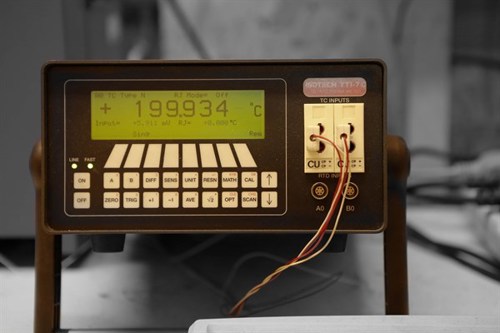What is a thermocouple?

A thermocouple is primarily a device used to measure temperature. However, when used in a layered format, they can also be used to power very low-energy devices, such as fans converting heat into electrical power.
Thomas Johann Seebeck discovered that when any conductor is subjected to a thermal gradient, it will generate a voltage. This is known as the thermoelectric effect or the Seebeck effect. Measurement of this voltage involves connecting another conductor to the "hot" end. This additional conductor will then also experience the temperature gradient and develop a voltage of its own which will oppose the original. Using a dissimilar metal to complete the circuit creates a circuit in which the two legs generate different voltages, leaving a small difference in voltage available for measurement. That difference increases with temperature.
Although the physics may seem quite complex, the actual use and operation of a thermocouple measuring circuit are quite simple, usually involving the connection of only two colour-coded wires to an instrument, which in turn converts the mV input generated by the wires into a usable temperature read out. Most instruments commercially available have an internal “zero” reference and so the need to place the “cold” end of the junction in stirred ice baths or zero reference units is negated.
However, for accurate calibration of a thermocouple, it is advisable to use a zero reference unit for greater accuracy of the test.
Why are there different types?
Unfortunately, there is no “one size fits all” thermocouple available at the moment, and the different types available offer different advantages and disadvantages, including accuracy, longevity at temperature, stability at temperature and not forgetting the different environmental conditions that the thermocouple is expected to perform in. There are many variables to correct thermocouple selection and it is important to understand the application and its requirements before selection. It is common to demand a high-accuracy thermocouple (class 1 or quarter tolerance) where the actual application or use negates the high accuracy due to poor heating or cooling control systems. The different types exist to allow temperature measurement in a wide range of environments and a wide range of temperatures with a good degree of accuracy and response time.
The most common types in use are Type K, Type J and Type T. Other types are less used but have their own place in the measurement world. Other available types are E, N, R, S, B, G, C and D. Compensating cables are generally Type KCB ( K comp) RCA ( R/S comp).
Thermocouple, extension grade, compensating grade class 1, class 2.
Thermocouple grade, extension grade and compensating grade are not directly related to Class 1 and Class 2, at least not directly. A thermocouple grade is a material that can be used to do the measurement, but due to either cost or the distance that the measurement system is away from the control system, extension-grade materials can be connected to the tails of the thermocouple.
Extension grade materials are generally made of the same materials as the thermocouple grade but are only usually tested to a low temperature. For example, a typical calibration for a type K Thermocouple grade will be up to 1000 or 1100 degrees C but the extension grade material is only typically tested to 100 degrees C it is this lower test level that reduces the cost of extension grade and not the contents of the product.
If long runs are needed it is advisable to use Compensating grade, not just for the reduced cost, but more for the resistance of the measurement circuit which should not, in an ideal world, exceed 100 ohms as exceeding this limit may result in measurement errors. Compensating wires are generally made with a copper leg and a copper-nickel alloy leg. These two metals have a lower resistance than the thermocouple alloy, allowing for longer runs without induced error. Typically the greater the distance the larger the wires cross-section needs to be in order to remain below 100 ohms.
The “Class” of a thermocouple has nothing to do with its operating temperature range but relates exclusively to the “tolerance” of the material. That is to say the allowable error in the wires' temperature measurement range. Class 2 has the widest error margin with class 1 typically (but not exclusively) approximately half that of Class 2.
Class 1 is very similar to ANSI special limits, with ANSI special limits having a slightly tighter tolerance than Class 1 at certain temperatures. A newer requirement typically specified by aerospace is “quarter tolerance” this is approximately half the class 1 allowable error and gives very tight tolerances of measurement. Quarter tolerance material needs to be handled with extreme care as over bending or stressing the wire in any way will result in a drift of the error which may take it beyond its quarter tolerance specification.
The process of stranding or bunching wires together is sufficient to drift the alloys out of the quarter tolerance range. Any sort of work hardening of the wire or annealing of the wire will cause quarter tolerance material to no longer be in spec. It is not advisable to use quarter tolerance material more than once without re-calibrating the wire.
What is a calibration?
A calibration of a thermocouple implies that it can somehow be altered if it is not of sufficient accuracy, or that re-calibration can correct an induced error. This is a myth.
Calibration of a thermocouple allows the user to know what the exact error is (within the limits of uncertainty measurement) at a given temperature. Typical calibrations are done at 100, 200, 400, 600, 800 and 1000 degrees C, but for true accuracy, it is best to specify a tighter range of temperatures, especially if the temperature that it will be used at is a known constant.
If for example your temperature range in use is limited to 255 degrees C then it is best to calibrate the material at this temperature. This will then give you the error of the thermocouple at this temperature and most modern instruments allow you to enter the offset to compensate for the error in the probe, thereby increasing your process accuracy and repeatability.
It is possible to correct small errors within a thermocouple by either working on hardening the material or stress relieving it. By doing this you can drift a thermocouple up and down the EMF scale by small amounts. Although this is not really advisable and not practicable in most applications.
All measurements have a degree of uncertainty; these are the induced errors by the calibration equipment, and errors that at the time of the test you cannot know. However you can calculate these unknowns as your test system should be a constant, any calibration certificate that does not list the uncertainty measurement is simply not worth the paper it’s written on and should be immediately discarded.
The lower the uncertainty measurement the more the test equipment typically costs. An uncertainty measurement should be stated as an error between specific temperatures and then an expanded factor typically K=2, which in this instance tells you that your results will be repeatable 95% of the time within the stated uncertainty. This measurement also tells you just how accurate the calibration of the material was. Very high uncertainty measurements will almost certainly lead to high measurement errors.
Probes should be re-calibrated at regular intervals, especially if they are being used at elevated temperatures as thermocouples tend to suffer with drift over time. This is not a rapid change in the thermocouples readout, but a slow degradation of the material. It is possible over long time frames for probes to achieve very significant errors which go unnoticed.
Further reading
There are many good books and reference guides on the internet that will help explain the complexity of temperature measurement, some are very simple and are good for the beginner others are more in-depth and require some basic knowledge to start with. Some of the larger thermocouple cable probe makers have their own reference books which are a good start for the beginner but gloss over the deeper issues.
A must-read for anyone serious about understanding temperature measurement is “Traceable Temperatures” by JV Nicholas and D.R White. ISBN number 0-471-49291-4. “A beginners guide to Uncertainty Measurement” by Stephanie Bell will help understand the importance of uncertainty statements. Some companies run training courses for people who already have some basic knowledge. Isothermal Technology runs a useful two-day course.



